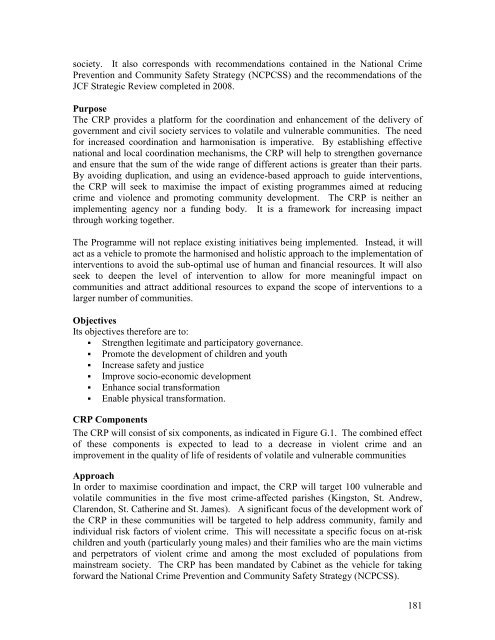PIOJ Growth-Inducement Strategy - Planning Institute of Jamaica
PIOJ Growth-Inducement Strategy - Planning Institute of Jamaica
PIOJ Growth-Inducement Strategy - Planning Institute of Jamaica
You also want an ePaper? Increase the reach of your titles
YUMPU automatically turns print PDFs into web optimized ePapers that Google loves.
society. It also corresponds with recommendations contained in the National Crime<br />
Prevention and Community Safety <strong>Strategy</strong> (NCPCSS) and the recommendations <strong>of</strong> the<br />
JCF Strategic Review completed in 2008.<br />
Purpose<br />
The CRP provides a platform for the coordination and enhancement <strong>of</strong> the delivery <strong>of</strong><br />
government and civil society services to volatile and vulnerable communities. The need<br />
for increased coordination and harmonisation is imperative. By establishing effective<br />
national and local coordination mechanisms, the CRP will help to strengthen governance<br />
and ensure that the sum <strong>of</strong> the wide range <strong>of</strong> different actions is greater than their parts.<br />
By avoiding duplication, and using an evidence-based approach to guide interventions,<br />
the CRP will seek to maximise the impact <strong>of</strong> existing programmes aimed at reducing<br />
crime and violence and promoting community development. The CRP is neither an<br />
implementing agency nor a funding body. It is a framework for increasing impact<br />
through working together.<br />
The Programme will not replace existing initiatives being implemented. Instead, it will<br />
act as a vehicle to promote the harmonised and holistic approach to the implementation <strong>of</strong><br />
interventions to avoid the sub-optimal use <strong>of</strong> human and financial resources. It will also<br />
seek to deepen the level <strong>of</strong> intervention to allow for more meaningful impact on<br />
communities and attract additional resources to expand the scope <strong>of</strong> interventions to a<br />
larger number <strong>of</strong> communities.<br />
Objectives<br />
Its objectives therefore are to:<br />
• Strengthen legitimate and participatory governance.<br />
• Promote the development <strong>of</strong> children and youth<br />
• Increase safety and justice<br />
• Improve socio-economic development<br />
• Enhance social transformation<br />
• Enable physical transformation.<br />
CRP Components<br />
The CRP will consist <strong>of</strong> six components, as indicated in Figure G.1. The combined effect<br />
<strong>of</strong> these components is expected to lead to a decrease in violent crime and an<br />
improvement in the quality <strong>of</strong> life <strong>of</strong> residents <strong>of</strong> volatile and vulnerable communities<br />
Approach<br />
In order to maximise coordination and impact, the CRP will target 100 vulnerable and<br />
volatile communities in the five most crime-affected parishes (Kingston, St. Andrew,<br />
Clarendon, St. Catherine and St. James). A significant focus <strong>of</strong> the development work <strong>of</strong><br />
the CRP in these communities will be targeted to help address community, family and<br />
individual risk factors <strong>of</strong> violent crime. This will necessitate a specific focus on at-risk<br />
children and youth (particularly young males) and their families who are the main victims<br />
and perpetrators <strong>of</strong> violent crime and among the most excluded <strong>of</strong> populations from<br />
mainstream society. The CRP has been mandated by Cabinet as the vehicle for taking<br />
forward the National Crime Prevention and Community Safety <strong>Strategy</strong> (NCPCSS).<br />
181
















